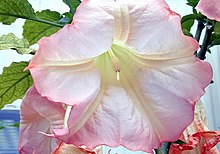
Solanaceae
Family of flowering plants that includes tomatoes, potatoes and tobacco / From Wikipedia, the free encyclopedia
Dear Wikiwand AI, let's keep it short by simply answering these key questions:
Can you list the top facts and stats about Solanaceae?
Summarize this article for a 10 year old
The Solanaceae (/ˌsɒləˈneɪsi.iː, -ˌaɪ/),[2] or the nightshades, are a family of flowering plants that ranges from annual and perennial herbs to vines, lianas, epiphytes, shrubs, and trees, and includes a number of agricultural crops, medicinal plants, spices, weeds, and ornamentals. Many members of the family contain potent alkaloids, and some are highly toxic, but many—including tomatoes, potatoes, eggplant, bell, and chili peppers—are used as food. The family belongs to the order Solanales, in the asterid group and class Magnoliopsida (dicotyledons).[3] The Solanaceae consists of about 98 genera and some 2,700 species,[4] with a great diversity of habitats, morphology and ecology.
| Solanaceae | |
|---|---|
 | |
| A flowering Brugmansia suaveolens from the US Botanic Garden | |
| Scientific classification | |
| Kingdom: | Plantae |
| Clade: | Tracheophytes |
| Clade: | Angiosperms |
| Clade: | Eudicots |
| Clade: | Asterids |
| Order: | Solanales |
| Family: | Solanaceae Juss. |
| Subfamilies[1] | |
| |

The name Solanaceae derives from the genus Solanum. The etymology of the Latin word is unclear. The name may come from a perceived resemblance of certain solanaceous flowers to the sun and its rays. At least one species of Solanum is known as the "sunberry". Alternatively, the name could originate from the Latin verb solare, meaning "to soothe", presumably referring to the soothing pharmacological properties of some of the psychoactive species of the family.
The Solanaceae family includes a number of commonly collected or cultivated species. The most economically important genus of the family is Solanum, which contains the potato (S. tuberosum, in fact, another common name of the family is the "potato family"), the tomato (S. lycopersicum), and the eggplant or aubergine (S. melongena). Another important genus, Capsicum, produces both chili peppers and bell peppers.
The genus Physalis produces the so-called groundcherries, as well as the tomatillo (Physalis philadelphica) and Physalis peruviana (Cape gooseberry). Alkekengi officinarum (Chinese Lantern) was previously included in the genus Physalis (as Physalis alkekengi), until molecular and genetic evidence placed it as the type species of a new genus.[5][6] The genus Lycium contains the boxthorns and the goji berry, Lycium barbarum. Nicotiana contains, among other species, tobacco. Some other important members of Solanaceae include a number of ornamental plants such as Petunia, Browallia, and Lycianthes, and sources of psychoactive alkaloids, Datura, Mandragora (mandrake), and Atropa belladonna (deadly nightshade). Certain species are widely known for their medicinal uses, their psychotropic effects, or for being poisonous.[7]
This family has a worldwide distribution, being present on all continents except Antarctica. The greatest diversity in species is found in South America and Central America. In 2017, scientists reported on their discovery and analysis of a fossil species belonging to the living genus Physalis, Physalis infinemundi, found in the Patagonian region of Argentina, dated to 52 million years ago. The finding has pushed back the earliest appearance of the plant family Solanaceae.[8] Most of the economically important genera are contained in the subfamily Solanoideae, with the exceptions of tobacco (Nicotiana tabacum, Nicotianoideae) and petunia (Petunia × hybrida, Petunioideae).
Many of the Solanaceae, such as tobacco and petunia, are used as model organisms in the investigation of fundamental biological questions at the cellular, molecular, and genetic levels.[9][10]